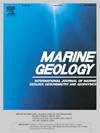Geological, geophysical, and geobiological investigation of the inactive Nawaay`as hydrothermal vent field at West Valley, Juan de Fuca Ridge
IF 2.2
3区 地球科学
Q2 GEOSCIENCES, MULTIDISCIPLINARY
引用次数: 0
Abstract
In 2022, an area of now-inactive hydrothermal venting, named the Nawaay`as field, was discovered on a sediment-covered volcanic mound within the axial valley of the West Valley segment of the Juan de Fuca Ridge, northeast Pacific Ocean. Analysis of multibeam backscatter imagery of the ridge segment indicates that volcanic activity along the ridge has resulted in, at minimum, two distinct eruptive events along the valley floor. Younger lava flows emanated from a volcano located near the southern end of the valley, then flowed north, paving over areas of bathymetric lows, but flowing around and thus preserving areas of relative bathymetric highs, including the volcanic mound that hosts the Nawaay`as field. Geochemical and petrographic analysis of Nawaay`as hydrothermal rock samples indicate that the deposit formed over venting temperatures ranging from ∼100 to 300 °C. Although the valley floor is generally sediment-free, trace metal concentrations within the sulfide-rich rock samples suggest that hydrothermal fluids interacted with buried sediments. Distinct differences in deep-sea sponge communities were observed between basaltic and inactive sulfidic substrates at West Valley, indicating that inactive hydrothermal deposits are unique seafloor habitats. Observations of shimmering water, vent-associated fauna, and recent seismic activity suggest the presence of active hydrothermal venting to both the north and south of Nawaay`as. With recent increased interest in the mineral resource potential of the seafloor, studies of inactive vent sites such as Nawaay`as are critical to ensure informed, risk-mitigating marine policy decisions are made in the future.
对Juan de Fuca Ridge West Valley不活跃的Nawaay 'as热液喷口进行地质、地球物理和地质生物学调查
2022年,在太平洋东北部Juan de Fuca山脊西谷段轴向山谷内的沉积物覆盖的火山丘上发现了一个现已不活跃的热液喷口区域,名为Nawaay 'as田。对山脊段的多波束后向散射图像的分析表明,沿山脊的火山活动至少导致了沿谷底的两次不同的喷发事件。年轻的熔岩流从山谷南端附近的一座火山喷发出来,然后向北流动,覆盖了水深较低的地区,但在周围流动,从而保留了相对水深较高的地区,包括拥有纳威亚斯油田的火山丘。Nawaay’as热液岩石样品的地球化学和岩石学分析表明,该矿床形成于喷口温度为~ 100 ~ 300°C。虽然谷底通常没有沉积物,但富含硫化物的岩石样品中的微量金属浓度表明,热液流体与埋藏的沉积物相互作用。在西谷的玄武岩和不活跃的硫化物基质中,深海海绵群落存在明显差异,表明不活跃的热液沉积物是独特的海底栖息地。对闪闪发光的水、与喷口相关的动物群和最近的地震活动的观察表明,在纳威亚斯的北部和南部都存在活跃的热液喷口。随着最近人们对海底矿产资源潜力的兴趣日益浓厚,对Nawaay 'as等不活跃喷口的研究对于确保未来做出明智的、降低风险的海洋政策决定至关重要。
本文章由计算机程序翻译,如有差异,请以英文原文为准。
求助全文
约1分钟内获得全文
求助全文
来源期刊

Marine Geology
地学-地球科学综合
CiteScore
6.10
自引率
6.90%
发文量
175
审稿时长
21.9 weeks
期刊介绍:
Marine Geology is the premier international journal on marine geological processes in the broadest sense. We seek papers that are comprehensive, interdisciplinary and synthetic that will be lasting contributions to the field. Although most papers are based on regional studies, they must demonstrate new findings of international significance. We accept papers on subjects as diverse as seafloor hydrothermal systems, beach dynamics, early diagenesis, microbiological studies in sediments, palaeoclimate studies and geophysical studies of the seabed. We encourage papers that address emerging new fields, for example the influence of anthropogenic processes on coastal/marine geology and coastal/marine geoarchaeology. We insist that the papers are concerned with the marine realm and that they deal with geology: with rocks, sediments, and physical and chemical processes affecting them. Papers should address scientific hypotheses: highly descriptive data compilations or papers that deal only with marine management and risk assessment should be submitted to other journals. Papers on laboratory or modelling studies must demonstrate direct relevance to marine processes or deposits. The primary criteria for acceptance of papers is that the science is of high quality, novel, significant, and of broad international interest.
 求助内容:
求助内容: 应助结果提醒方式:
应助结果提醒方式:


